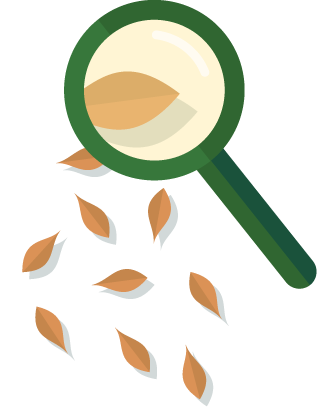
Whole grain barley is a whole grain with a chewy texture and mild, nutty flavour.
You can use it in soups or grain salads, or as a substitute for rice, paired with curries or stir-fried with vegetables. Barley is also used in making breads, breakfast cereals, and beverages.
Whole grain barley pairs well with mushrooms, root vegetables, warm spices, and autumnal produce.

Whole grain barley is a nutrient-dense whole grain that provides a wide array of nutrients. It is high in fibre, iron, vitamin B1 (thiamine), vitamin B3 (niacin), and vitamin B6. Barley is also a source of magnesium, phosphorus, potassium, zinc, copper, and folate.
A type of fibre that is found in whole grain barley is beta-glucan, a soluble fibre. Soluble fibre dissolves in water and forms a gel-like substance, aiding in digestion and regulating blood sugar levels. This can help people with diabetes improve control their blood glucose levels. The European Food Safety Authority has approved a health claim on the relationship of beta-glucans from barley (and oats) and health, stating that: consumption of beta-glucans from oats or barley as part of a meal contributes to the reduction of the blood glucose rise after that meal.
Barley contains gluten.

Toggle with the tables below to compare their nutritional content per 100 g (both cooked and uncooked) and per average portion size. You might be surprised by the differences!
| Grains | Kcal | Protein | Fat | Saturated fat | Carbohydrates | Fibre |
|---|---|---|---|---|---|---|
| Pearl barley, Per 100 g, cooked | 123.00 | 2 | 0 | 0 | 28 | 3 |
| Pearl barley, Per 100 g, uncooked | 352.00 | 9 | 1 | 0 | 77 | 15 |
| Whole grain barley, Per 100 g, uncooked | 354.00 | 12 | 2 | 0 | 73 | 17 |
Whole grains are all packed with carbohydrates and dietary fibre (which is a type of carbohydrate) and are naturally low in (saturated) fat. Fibre is important for our health and the prevention of many chronic diseases. That’s why the European Food Safety Authority (EFSA) recommends we eat at least 25 g of fibre per day. Sometimes, you might see whole grains labelled as ‘high in fibre’ or ‘source of fibre’ – but what does that really mean?
| Grains (% of DRV) | Calcium | Magnesium | Phosphorus | Potassium | Iron | Zinc | Copper | Vit. B1 | Vit. B2 | Vit. B3 | Vit. B6 | Folate |
|---|---|---|---|---|---|---|---|---|---|---|---|---|
| Pearl barley, per 100 g, cooked | 1.38 | 5.87 | 7.71 | 4.65 | 9.50 | 8.20 | 10.50 | 7.55 | 4.43 | 12.88 | 8.21 | 4.85 |
| Pearl barley, per 100 g, uncooked | 3.63 | 21.07 | 31.57 | 14.00 | 17.86 | 21.30 | 42.00 | 17.36 | 8.14 | 28.75 | 18.57 | 6.06 |
| Pearl barley, per portion, cooked | 0.96 | 4.11 | 5.40 | 3.26 | 6.65 | 5.74 | 7.35 | 5.28 | 3.10 | 9.01 | 5.75 | 3.39 |
| Pearl barley, per portion, uncooked | 2.54 | 14.75 | 22.10 | 9.80 | 12.50 | 14.91 | 29.40 | 12.15 | 5.70 | 20.13 | 13.00 | 4.24 |
| Whole grain barley, per 100 g, uncooked | 4.13 | 35.47 | 37.71 | 22.60 | 25.71 | 27.70 | 49.80 | 58.73 | 20.36 | 28.75 | 22.71 | 5.76 |
| Whole grain barley, per portion, uncooked | 2.89 | 24.83 | 26.40 | 15.82 | 18.00 | 19.39 | 34.86 | 41.11 | 14.25 | 20.13 | 15.90 | 4.03 |
% of DRV stands for dietary reference value. DRV stands for dietary reference value. These values estimate how much of a nutrient most healthy people in Europe need each day. Ideally, we should aim to reach 100% of these values daily. Each vitamin and mineral has their own DRV, as set by EFSA.
You might have heard that whole grains are ‘high in,’ ‘rich in,’ or ‘source of’ a certain vitamin or mineral. These term are regulated by EFSA and products must meet specific rules to be considered as such. Here’s how to interpret these contributions:

Store in an airtight container in a cool, dry place. Follow the instructions on the packaging to keep the food good for as long as possible.
Whole grain barley has a best-before date, meaning that it can often be eaten after that date has passed. If it looks, smell and tastes good, and the packaging is also intact, it will most likely be safe.

Follow the instructions on the packaging to cook whole grain barley.
Use a ratio of 1 part of barley to 3 parts of water. Bring to boil, then simmer 45-60 minutes until tender.

Whole grain barley, hulled barley or hull-less barley is considered a whole grain. Only the inedible outer shell (hull) has been removed during processing.
Pearl barley is not considered a whole grain because parts of the bran have been removed, making it a refined grain. Although pearl barley is a refined grain, some of the bran may still be present and the fibre in barley is distributed throughout the kernel, not just in the outer bran layer.
Learn to identify whole grain products, cook delicious meals, find practical tips for a smooth, gradual switch, and much more!